Florida Trees and Shrubs
Page 3 of 11
Gumbo Limbo, Jamaica caper-tree, Seagrape tree, Pigeon Plum, Swamp Dogwood, Buttonwood, Lancewood, Black Mangrove, White Mangrove, Red Mangrove, Shoebutton Ardisia, Carrotwood
Gumbo Limbo - Bursera simaruba
Family - Burseraceae
Native

%20_small.jpg)

Coastal Hammocks, endemic to Florida within the continental U.S..
Deciduous tree, 25-40 feet tall with an equal spread, may grow to 75 feet, though this is rare. Distinguished by its thin, copper colored, smooth peeling bark with green trunk underneath. Leaves are alternate, pinnately compound with leaflets having entire margins, elliptic to ovate, green, 2-4+ inches long. Inconspicuous green flower in spring.
Tolerant of a range of soils and salt spray, drought resistant when established and very wind resistant. Full sun to light shade.
Jamaica Caper Tree - Capparis cynophallophora
Family - Capparaceae
Native
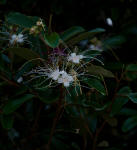

Coastal Scrub & Hammocks of South Florida.
Jamaica caper is a slow growing native tree that grows as a large shrub / small tree to a maximum height of about 20 feet, the stiff dark green leaves are 2-4 inches long and have bronze colored undersides. When grown in full sun the vase shaped canopy is very dense, as the amount of sunlight it receives decreases the canopy becomes more open and spreading.
Flower - Fragrant white flowers are produced primarily in spring with occasional flowers possible throughout the year, flowers turn pinkish-purple after opening and are followed by brown, fuzzy seed pods 2-7 inches long. These seed pods split open to reveal a fleshy orange inside with several 1/4 inch round, black seeds which several species of birds consume whole.
Seagrape tree - Coccoloba uvifera
Family - Polygonaceae
Native
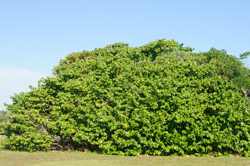
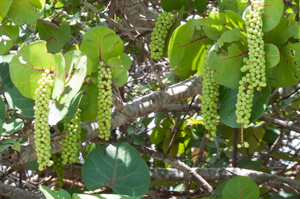

Growing in the sandy soils on the landward side and back from coastal sand dunes, along the coastal strand and in coastal hammocks. Common as a smaller tree 15-30 feet tall with an equal spread, usually with multiple low branching trunks, may reach 45-50 feet.
Leaves are broad, dark green, 8 to 12 inches almost circular in shape with distinctive red veins. New growth in spring is a shiny copper color. Ivory-white flowers are produced on racemes up to 30 inches long, followed by clusters of green 3/4 inch diameter grape-like berries that turn dark purple when ripe.
Pigeon Plum - Coccoloba diversifolia
Family - Polygonaceae
Native
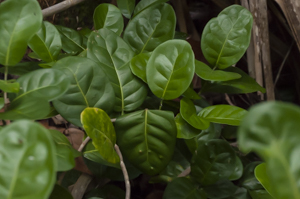


The Pigeon-plum tree is a densely branched tree with a rounded canopy that may grow from 15 feet to 35 plus feet tall and have a trunk diameter of 1-2 feet. This tree is found in S. Florida coastal regions from Cape Canaveral southward to the Keys, common to South Florida’s hardwood hammocks. Also present in the Caribbean, Central America and southern Mexico.
Leaves are alternate, oblong to ovate in shape, 2 to 4 inches long, bright to dark green color and may be shiny or dull on upper surface, paler green underneath, new leaves are a copper color.
Flowers are whitish green appear in clusters on 2"–6" long racemes. Fruit is a berry like achene, green turning red to dark purple when ripe.
Buttonwood - Conocarpus erectus
Family - Combretaceae
Native
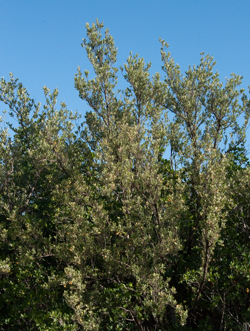
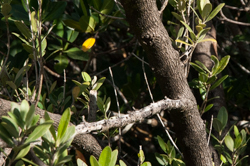
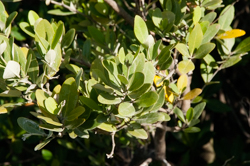

Found on the shorelines of estuaries on the peninsula south of Cape Canaveral, growing above the high tide line.
Multi-stemmed shrub or as a small tree, usually 15 feet or less, leaves are alternately arranged, elliptic to lanceolate shaped and about 4 inches in length. Leaf is shiny dark green on the top, lighter green with fine hairs on the bottom surface, leaf margins are entire. Buttonwood is a very salt resistant and tough native tree well adapted to harsh conditions and is often found growing in association with mangroves.
Lancewood - Ocotea coriacea
Family - Lauraceae (Laural family)
Native
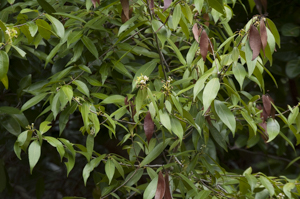

Lancewood found primarily in moist tropical hammocks near the coast, and may grow as shrub or as a small tree 20 feet (+/-) tall, leaves are 3-6 inches long, simple, with entire margins, lanceolate to elliptical in shape with acute tips, dark green above and a lighter green below. The leaves are aromatic when crushed, petoilies have a fishhook or "J" shaped bend.
Trunk can be up to 19 inches in diameter, The lancewood tree has bark that is gray when young, then turning reddish-brown with age. Flowers are white/creamy white.
White Mangrove - Laguncularia racemosa
Family - Combretaceae
Native
_small.jpg)

Common tree on the shorelines of estuaries and bays. White mangrove generally occurs on the upland side of the mangrove forest in saturated, stagnant soils above the high water mark.
White mangrove cab be distinguished from the other mangroves as having no aerial roots and also by the leaves that are elliptical in shape, light yellowish-green in color, with a pair of small salt excreting glands found at the base of the leaves. Fruit is a greenish somewhat flattened drupe, wider toward the tip with numerous length-wise ridges.
Red Mangrove - Rhizophora mangle
Family - Rhizophoraceae
Native


The Red mangrove tree is found along shorelines of bays and estuaries of coastal counties on the central and southern peninsula of Florida below the freeze line.
The red mangrove can grow to 70 feet or more in height, more often a multi-stemmed shrub or smaller tree to around 20 feet.
Easily recognized by numerous reddish aerial roots called prop (or stilt) roots, which provide an important protective nursery habitat for many marine species. Leaves are opposite, elliptical, the margin is entire, smooth, 1 to 5 inches long shiny green above, paler green below. A unique trait of the Red Mangrove tree is the seeds which germinate in the summer and fall, producing a tap root while still attached to the tree. These drop into the water, drifting with wind and currents until finally taking root in the shallow waters at the shoreline.
Black Mangrove - Avicennia germinans
Family - Verbenaceae
Native


Black mangrove grows on the shorelines and tidal flats of bays and estuaries of coastal counties on the Florida peninsula.
Growing to 50 feet in height often further inland than the other mangroves. Black mangrove is easily identified by its many above ground root projections called pneumatophores, which project upwards from lateral underground roots, these finger like projections help provide oxygen to the trees roots.
Leaves are opposite, elliptical to obovate, 2 to 5 inches long, dark green above, lighter green to yellowish silvery hairy below, the leaves often have salt crystals on their surfaces as the tree excretes excess salt through them.
Swamp Dogwood - Cornus foemina
Family - Cornaceae
Native
_small.jpg)
_small.jpg)
Small tree or large shrub found in swamps, mesic hammocks, floodplains of rivers and creeks, growing to about 15 feet tall, leaves are simple, opposite, elliptic to lanceolate, dark green above and a lighter green on the undersides, margins entire, undulate. Flowers are small white or slightly greenish produced in clusters in spring. Fruits are a bluish rounded drupe up to about 1/2 inch in diameter. Birds and other animals eat the fruit.
Shoebutton Ardisia, Duckeyes - Ardisia elliptica
Family - Myrsinaceae
Invasive / Exotic
_small.jpg)


This tree / shrub is found wet flatwoods, bottomland forest, and other moist sites.
Evergreen shrub or small tree to 17 feet with smooth stems. Native to the western coast of India to SE China and surrounding islands. New growth is reddish. Leaves are alternate, leathery, oblong to oval with entire margins, up to 8 inches long.
Flower - Mauve, star shaped, 1/2 inch across, borne in axillary clusters. Fruit is a small rounded black drupe. Distinguished from native Marlberry by reddish new growth and flowers, which are at leaf axils rather than terminal clusters, the native Marlberry tree has white flowers.
Carrotwood, Tuckaroo - Cupaniopsis anacardioides
Family - Sapindaceae (Soapberry family)
Invasive / Exotic



This invasive tree is originally from Australia, it was introduced to Florida as a landscape plant. This tree produces very large numbers of fruit and seeds that are eaten and spread by birds and other animals creating new infestations. Carrotwood grows to around 30 feet and has dark green, leathery, pinnately compound leaves. Adaptable to various soil and moisture conditions, Carrotwood is a serious threat to mangrove forests and swamp habitats.